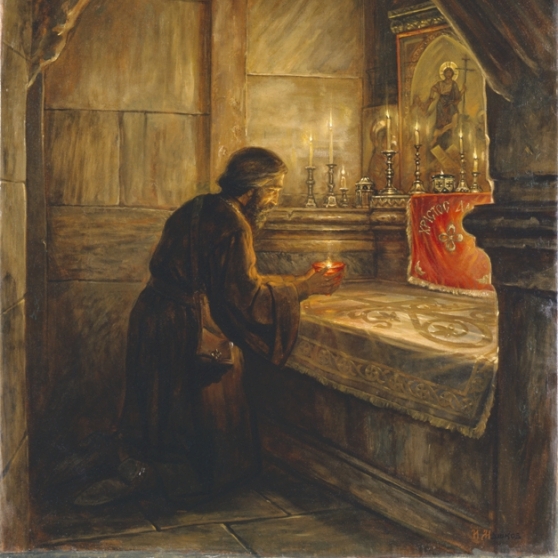
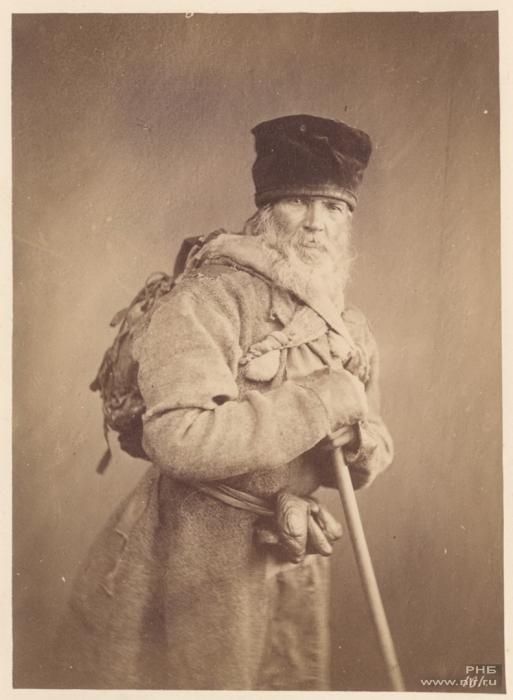
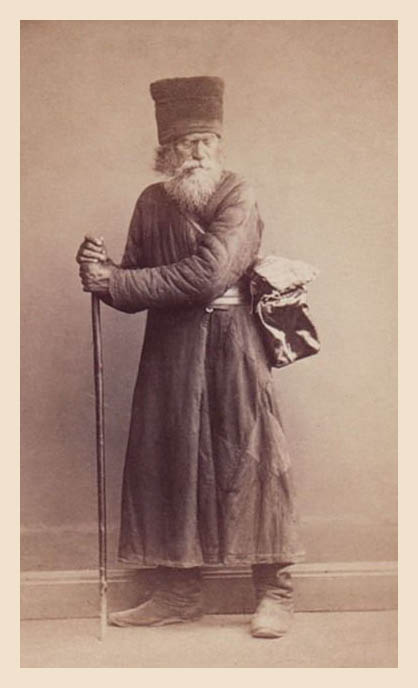
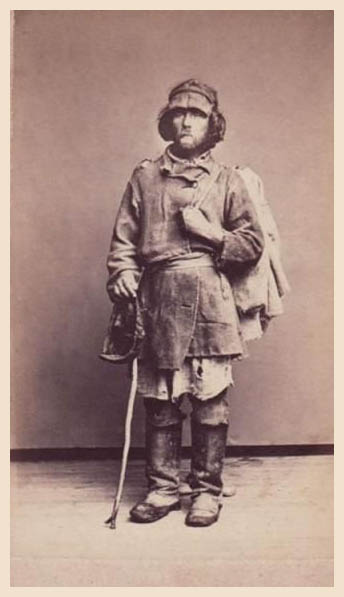

The description by Anthony, Archbishop of Novgorod, who visited S. Sophia in 1200, three years before the capture by the Crusaders, furnishes the best account of the accumulated riches of the great church. We give this in full from the French version contained in "Itineraires Russes en Orient"}
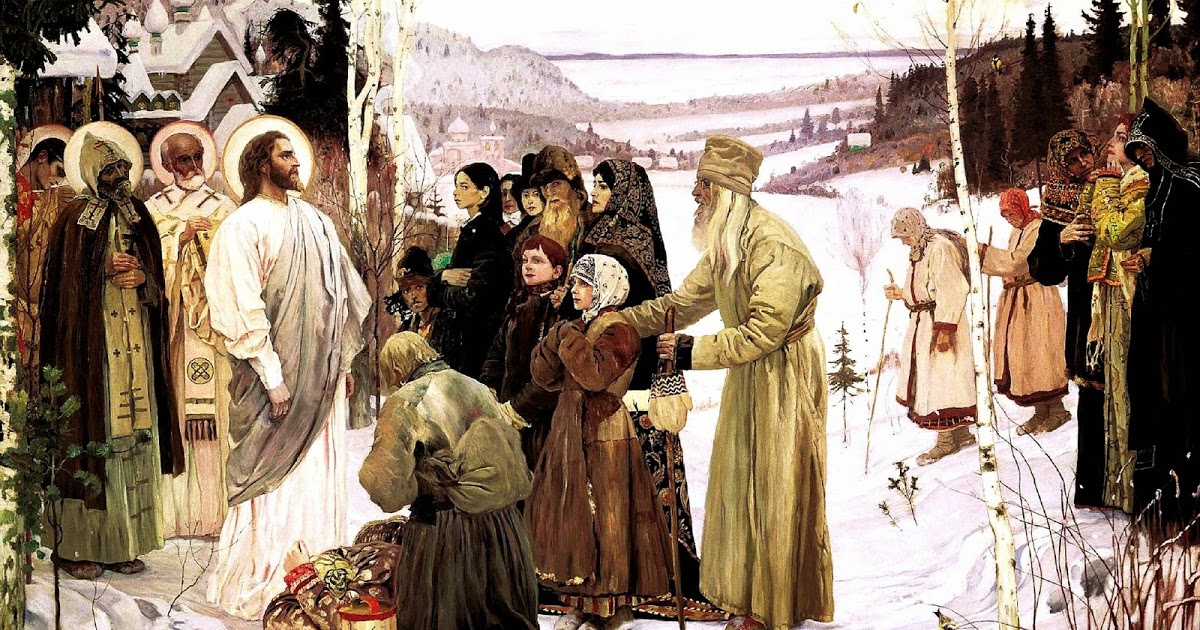 I, Antonius, Archbishop of Novgorod, an unworthy and humble sinner, by the grace of God and by the help of S. Sophia, who is the Wisdom and the Eternal Word, reached in safety the imperial city, and entered the great Catholic and Apostolic Church. We first worshiped S. Sophia, kissing the two slabs of the Lord's sepulchre. Furthermore we saw the seals, and the figure of the Mother of God, nursing Christ. This image a Jew at Jerusalem pierced in the neck with a knife, and blood flowed forth. The blood of the image, all dried up, we saw in the smaller sanctuary.
I, Antonius, Archbishop of Novgorod, an unworthy and humble sinner, by the grace of God and by the help of S. Sophia, who is the Wisdom and the Eternal Word, reached in safety the imperial city, and entered the great Catholic and Apostolic Church. We first worshiped S. Sophia, kissing the two slabs of the Lord's sepulchre. Furthermore we saw the seals, and the figure of the Mother of God, nursing Christ. This image a Jew at Jerusalem pierced in the neck with a knife, and blood flowed forth. The blood of the image, all dried up, we saw in the smaller sanctuary.
In the sanctuary of S. Sophia is the blood of the holy martyr Pantaleon with milk, placed in a reliquary like a little branch or bough, yet without their having mixed. Besides that there is his head, and the head of the Apostle Quadratus, and many relics of other saints: the heads of Hermolaus and Stratonicus ; the arm of Germanus, which is laid on those who are to be ordained patriarchs; the image of the Virgin which Germanus sent in a boat to Rome, by sea ; and the small marble table on which Christ celebrated His Supper with the disciples, as well as His waddling clothes and the golden vessels, which the Magi brought with their offerings.
There is a large gold disc for the mass, given to the patriarch by Olga, a Russian princess, when she came to the imperial city to be baptized. In this disc there is a precious stone which displays the image of Christ, and the seal impressions from this are used as charms; but on the upper side the disc is adorned with pearls.
In the sanctuary is likewise preserved the real chariot of Constantine and Helena, made of silver; there are gold plates, enriched with pearls and little jewels, and numerous others of silver, which are used for the services on Sundays and feast days: there is water also in the sanctuary coming out of a well by pipes.
Outside the smaller sanctuary is erected the "Crux Mensuralis" which shows the height of Christ when on earth; and behind that cross is buried Anna, who gave her house to S. Sophia, where now is the smaller sanctuary, and she is buried near. And near this same smaller sanctuary are the figures of the holy women and of the Virgin Mother holding Christ, and shedding tears which fall on the eyes of Christ. They give of the water of the sanctuary for the blessing of the world. In the same part is the chapel of S. Peter the Apostle, where S. Theophania is buried. She was the guardian of the keys of S. Sophia, which people used to kiss. There is also suspended the carpet of S. Nicholas. The iron chains of S. Peter are kept there in a gold chest; during the feast of S. Peter's Chains the emperor, the patriarch, and all the congregation kiss them. Near by, in another chapel, is also shown the crystal of the ancient ambo, destroyed when the dome fell.
By the side of [the images of] the holy women is the tomb of the son of S. Athenogenius. There are no other tombs in S. Sophia except that, and a lamp hangs in front of it, which once fell, full of oil, without being broken. The place is enclosed by a wood screen, and the people are not allowed to enter.
When one turns towards the gate one sees at the side the column of S. Gregory the Miracle-Worker, all covered with bronze plates. S. Gregory appeared near this column, and the people kiss it, and rub their breasts and shoulders against it to be cured of their pains; there is also the image of S. Gregory. On his feast day the patriarch brings his relics to this column. And there placed above a platform is a great figure of the Saviour in mosaic; it lacks the little finger of the right hand When it was finished, the artist looked at it and said, "Lord, I have made thee as if alive." Then a voice coming from the picture said, "When hast thou seen me?" The artist was struck dumb and died, and the finger was not finished, but was made in silver-gilt.
Above the gate is depicted on a large panel the Emperor Leo the Wise, and in front of it is a precious stone, which illuminates S. Sophia at night-time. This same Emperor Leo took a certain writing from Babylon, which was found in the tomb of the prophet Daniel. It was copied, and on it were written the names of the Greek emperors. At the royal gate is a bronze romanistum or bolt by which the door is closed. Men and women are brought to it, and if they have drunk serpent poison or any other poison, they cannot remove the bolt from the mouth, until all the evil of the disease has trickled away with the saliva.
By the great altar on the left is the place where an angel of the Lord appeared to the boy who was guarding the workmen's tools, and said, "I will not leave this spot as long as S. Sophia shall remain." Three figures are shown in this place, for the angels are presented there; and a multitude of people come there to pray to God. Not far from there is the place where they boil the holy oil, burning underneath it old ikons, whose features one can no longer trace. With this oil they anoint children at baptism. Above the sanctuary there rises in the air a great hollow vault covered with gold. In the sanctuary are eighty candelabra of silver for use on feast days, which occupy the first place, besides numberless silver candelabra with many golden apples.
Above the great altar in the middle is hung the crown of the Emperor Constantine, set with precious stones and pearls. Below it is a golden cross, which overhangs a golden dove. The crowns of the other emperors are hung around the ciborium, which is entirely made of silver and gold. Thus the altar pillars and the sanctuary and the bema are built of gold and silver, ingeniously made, and very costly. From the same ciborium hang thirty smaller crowns, as a remembrance to Christians of the pieces of money of Judas. To the ciborium were attached curtains, which were formerly drawn by the bishops during the services. We asked why they did so, and they answered so that the priests should not see the women and the people, but should serve the supreme God with a pure heart and soul. Later the heretics,' when nobody could see them as they were behind the curtains, took the body and blood of Christ, and spat them out, and trampled on them. The Spirit warned the fathers of this heresy, and the fathers fixed the curtains to the columns of the ciborium, and set an archdeacon near the patriarch, metropolitan, or bishop, so that they should worship God holily without heresy. When Jerusalem was taken by Titus many sacred vessels and curtains were brought to [New] Rome with the royal treasures and given to the church of S. Sophia. In S. Sophia also are preserved the tables of the Law, as well as the Ark and manna. The subdeacons, when they sing ^ Alleluia ' in the ambo, hold in their hands tablets like those of Moses. During the procession of the Holy Sacrament the eunuchs commence to sing, and then the subdeacons, and then a monk chants alone. Then many priests and deacons carry the Holy Sacrament in procession; at this time all the people not only below, but also in the galleries, weep in great humility. What then ought to be the fear and humility of the bishops, the priests, and the deacons in this holy service?
How magnificent are the gold and silver chalices, garnished with precious stones and pearls when the splendid chest, called Jerusalem, is brought out with the flabella, there rises amongst the people a great groaning and weeping, but here is a wonderful miracle, which we saw in S. Sophia. Behind the altar of the larger sanctuary is a gold cross, higher than two men, set with precious stones and pearls. There hangs before it another gold cross a cubit and a half long, with three gold lamps, which hang from as many gold arms (the fourth is now lost). These lamps, the arms or branches, and the cross, were made by the great Emperor Justinian who built S. Sophia. By virtue of the Holy Spirit the small cross with the lamps ascended above the big cross, and again slowly came down again without going out. This miracle took place after matins, before the commencement of the mass: the priests who were in the sanctuary saw it, and ail the people in the church who saw it cried with fear and joy, "God in His mercy has visited us.'". This great and wonderful miracle was wrought by God in the year 6708 on Sunday, May 21st being the Commemoration of S. Constantine and his mother Helena, during the reign of the Emperor Alexius and the patriarchate of John. It was on the feast of the 318 fathers. Iverdiatinus Ostromitza was then living at Constantinople ; he was an ambassador from the great Roman duke. Nedanus, Domagirus, Demetrius, and Novgaro were also there.
At S. Sophia on the right near the sanctuary is a piece of red marble, on which they place a golden throne ; on this throne the emperor is crowned. This place was surrounded by bronze closures to prevent people walking on it; but the people kiss it. At this place the Holy Virgin prayed to her Son, our Lord, on behalf of all Christians ; a priest who was guarding the church at night saw her. On the same side is also the grand icon of S. Boris and S. Gleb, which artists copy. When officiating, the patriarch holds it high up in the tribune.
In the chapel behind the altar are affixed to the wall the upper slab of the Lord's sepulchre, the hammer, the gimlet, and the saw, with which the cross of the Lord was made; also the iron chain which was hung to the gate of S. Peter's prison, and the wood of the cross which Christ's neck touched. This is inserted in a reliquary in the form of a cross. In this chapel above the door is painted S. Stephen, protomartyr, and a lamp is hung before him; when any one has bad eyes, they put round his head the rope by which this lamp is hung, and his eyes are healed.
There is also the figure of Christ whose neck the Jew struck, and the bronze trumpet of Joshua, who took Jericho, and the marble mouth of the well of Samaria. Near it Christ said to the woman of Samaria, "Give me to drink" ; the well mouth has been cut in half, and the Samaritans still draw water [from the other half].
There lie also the bodies of S. Abercius, S. Gregory, and S. Sylvester, and the heads of Cyrus and John, and many other relics. There also is the Baptistery, upon which is painted all the history of the baptism of Christ by John in the Jordan: and how John taught the people, and how little children and men threw themselves in the Jordan : all this was executed by Paul the Skillful during my lifetime, and there is no painting like this. There are there wooden supports, upon which the patriarch has had placed the figure of Christ, thirty cubits high; Paul first painted the Christ with colors made of precious stones and crushed pearls mixed with water ; this image is still at S. Sophia.
And when they sing matins at S. Sophia, they sing first before the great doors of the church, in the narthex, then they enter and sing in the middle of the church ; then they open the paradise gates, and sing the third time before the altar. Sundays and saints days the patriarch assists at matins and at mass, then he blesses the singers from the ambo, they stop singing and then say the polykronia: then they begin to sing again, and sing as harmoniously and sweetly as the angels till the Mass. After matins are finished they put off their surplices and then go out and ask the patriarch*s benediction for the mass. After matins the prologue is read in the ambo till the mass; when the prologue is finished, the liturgy is commenced, and, after the service is over, the chief priest in the sanctuary recites the prayer called "Of the ambo," while the second priest recites it in the church on the side of the ambo, away from [the sanctuary]: both, when the prayer is finished, bless the people. In a similar way vespers are sung. There are no bells at S. Sophia, but a little hand-bat [hagiosidire] which they strike for matins, though they do not strike it for mass and vespers, as in other churches: they follow the precepts of the angel in having this bat; the Latins have bells.
When they built S. Sophia, they enclosed holy relics in the walls of the sanctuary. There are also many cisterns at S. Sophia. Above [evidently under] the galleries are the cisterns and storehouses of the patriarchs and of the Church. Vegetables of every kind [suitable for the table] of the patriarchs, melons, apples, and pears are preserved at the bottom of the cisterns in baskets hung by cords : when the patriarch wants to eat, they bring them up quite fresh : and the emperor eats them also. The bath of the patriarch is also above [under] the galleries ; the water of the fountains mounts by pipes, and the rainwater is preserved in cisterns. On the galleries are painted all the patriarchs and emperors of Constantinople, and those who shared their heresies. In the choirs of the church are five heads ornamented with pearls like a silver [word indecipherable] Lazarus, the image painter first painted at Constantinople, in the sanctuary of S. Sophia, the Virgin holding Christ and two angels S. Sophia has 3,000) priests; 500 share in the benefices of the church and 1,500 have no share; when one of the 500 priests dies, his place is taken by one of the 1,500.
From:
The Church of Sancta Sophia Constantinople
a study of Byzantine building
by W. R. Lethaby and Harold Swainson
1894
Macmillan & Co. London & New York

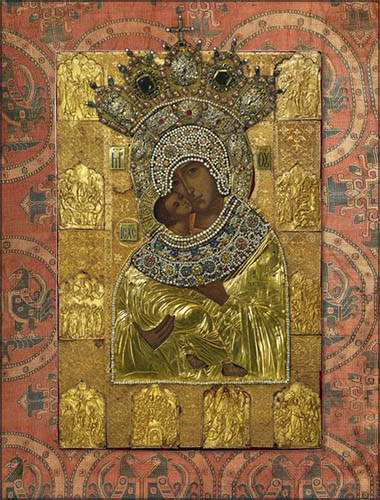


 click here for icons of christ
click here for icons of christ click here for icons of the theotokos
click here for icons of the theotokos click here for icons of angels
click here for icons of angels click here for icons of saints
click here for icons of saints








